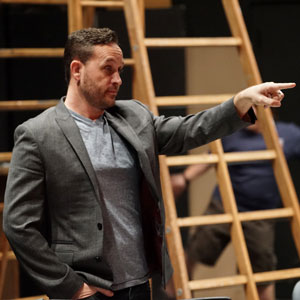The Drama Behind the Drama About Raoul Wallenberg
— OC Weekly - Joel Beers - Friday, December 1st, 2000
Think of it as a drama within a drama: onstage at the Fullerton College theater, 19-year-old Addison Glines is portraying Raoul Wallenberg, a World War II-era Swedish diplomat twice his age. Sometimes called the Swedish Schindler, Wallenberg was dispatched to Nazi-occupied Hungary by neutral Sweden on a mission to save as many Jews as possible. But Glines, or rather Wallenberg, is plagued: though he has saved 100,000 Jews from the death camps, he is haunted by the knowledge that for every one he saves, 10 are lost. And now, onstage, he is surrounded by the faces of people he could not reach in time. In a moment of powerful theater-as-documentary, Glines/ Wallenberg confronts oversize photos of actual Holocaust victims. Their eerie, disembodied faces seem to float in midair, serving as a stark, resonant memory of the devastation wrought by Germany upon Europe's Jews.
But the use of photos may be the least interesting intrusion of reality upon this stage. Wallenberg, who despaired of saving children, disappeared almost without rumor in 1945. And when Wallenberg opens tomorrow night, young Addison Glines won't be onstage.
Wallenberg's author is Fullerton College theater director Bob Jensen, a history buff who set out on a different task: to write a play about the husband of a Fullerton College administrator who was a Schindler's List survivor. But Jensen's mother, a Swedish-American, sent him a book of Wallenberg's letters and official dispatches from Hungary. Jensen was immediately captivated.
"What intrigued me most is the question of what causes someone to put themselves in harm's way," said Jensen. "It's one thing to have compassion; it's something else to risk your life for other people."
Jensen said he was especially attracted to Wallenberg's "methodology of saving."
"He was incredibly methodical," he said. "And that's what it took to outfox Eichmann and to outthink the Germans."
There is little in Wallenberg's biography to suggest he would outfox the Third Reich, Jensen added. He was a youngish businessman who until 1944 lived an unremarkable life and wasn't even a particularly good businessman. But he did have a pedigree: born in 1912 to a prominent family of Swedish bankers, businessmen and diplomats, he traveled extensively throughout the United States, studying architecture at the University of Michigan. In 1944, while working for a Stockholm trading company, Wallenberg came to the attention of a committee looking for someone to head the Swedish legation in Hungary.
Sweden was officially neutral in World War II, and its legation in Hungary was of paramount importance to the United States, which had finally decided to do something to help halt the massacre of European Jews. In 1944, Hungary was home to the last sizable community of European Jews. In March of that year, the Nazis unleashed Adolf Eichmann to take care of that. A few months later, Wallenberg arrived in Budapest to save the remnants of Hungary's Jewish community.
He had no guns and no political leverage, but he had courage and imagination. He created, printed and distributed a Schutzpass, a protective passport that ensured its holders Swedish protection. The passport, which had no real legal authority, was given to thousands of Jews. There are numerous stories of Wallenberg showing up on deportation trains, handing out the passes to condemned Jews. Those Jews with the Schutzpass were housed in "Swedish Houses," safe from Nazi aggression. According to biographers, his triumphant moment came in a January 1945 showdown with a high-ranking Nazi officer. With the Soviet Red Army massing on the outskirts of Budapest, the Nazis planned a last paroxysm of murder: the liquidation of the city's central ghetto, where some 70,000 Jews lived. Wallenberg discovered the plan and boldly threatened the SS general in charge—if the pogrom was carried out, Wallenberg told the man, he would personally see that the general was charged with genocide by a postwar tribunal. The pogrom was called off.
Despite being fertile dramatic territory, Wallenberg's life has been largely ignored. There's Good Evening, Mr. Wallenberg, an Eastern European film that Jensen described "as very dark. It captures the despair of a man who for every one Jew he saved, there were nine others who were killed. That preyed on him and caused him not to sleep. That nightmare imagery is something I focus on in the play. It was hard for him to sleep because he kept seeing the faces of those he couldn't save."
Reading Wallenberg during the Fullerton College playwrights' festival two years ago, Addison Glines felt a pain in his hip.
Then just 17, Glines was a walking, talking wunderkind who had graduated high school early to attend Fullerton College's much-praised theater program. He described his pain for a doctor on three separate occasions. Each time, the doctor said it was probably just a pulled muscle and would go away with stretching. On the third visit, the doctor turned down Glines' request for an x-ray.
Finally, when the pain grew too intense, Glines visited an emergency room and discovered his true ailment: Ewing's sarcoma, an aggressive tumor gnawing at his right pelvic bone. He immediately embarked on a 15-month ordeal of chemotherapy and radiation. As he describes it, he was the calmest member of his family.
"When we got the news, everyone around me was kind of falling apart, but I was relieved," Glines said last summer. "I knew what the problem was, and I just wanted to deal with it."
Glines, whose lifelong passion has been acting, was forced to take a 15-month sabbatical. During that time, he wrote Gabriel, a play produced in June as part of the Fullerton College Director's Festival. Gabriel was Glines' first play, but it signaled great promise. It was framed around a young man with a weak heart who is slowly wasting away in a hospital room. Love enters in the form of a spoiled volunteer nurse; romance flourishes amid the IVs and catheters. But unlike the triteness of an after-school special, there was no radiant happy ending.
Glines' life was more like the sappy after-school special. He beat his cancer. When his treatments ended in March, he jumped back into theater full time; in May, he was one of the highlights of a very good production of The Kentucky Cycle, directed by Jensen. Over the course of the play, Glines' character transformed from an energetic 16-year-old to a senile, drooling 80-year-old. In every scene, Glines either wore a hat or sported a buzzed haircut. It wasn't entirely by choice: his hair hadn't yet grown back after the chemo.
In June, Glines dominated the Fullerton College Playwrights Festival. In addition to his very fine play, Glines shone in Jonathan Mark Sherman's Womene and Wallace and Harold Pinter's The Dumbwaiter, both of which were selected as Best of the Fest entries.
Glines was enthusiastic about life. He'd found a lodestone of inspiration in the film The Dead Poets Society and its seize-the-day theme—he recently had the words "carpe diem" engraved on a watch he gave his girlfriend for her college graduation.
"That's what I strive for: to do as much as I can while I'm here and to learn and grow as an artist," Glines said. "And the best way to do that is to just do."
As recently as a few weeks ago, Glines' enthusiasm hadn't dimmed a bit. This semester, in addition to his work on Wallenberg, he played Oberon in Fullerton College's A Midsummer Night's Dream. He'd moved out of his parents' home and was going to school full time. His typical day consisted of class from 7:30 a.m. to 1 p.m., rehearsal for Wallenberg from 2 to 5 p.m., and rehearsal for Midsummer's Night from 7 to 10 p.m. or even midnight. He was intimately involved in the planning of Fullerton College's annual high school theater festival, which is held every March. In addition, he was busily preparing to apply at top-tier universities, including Carnegie Mellon.
The busy schedule concerned his mother, who nonetheless admitted her son would have it no other way. "He thinks he's making up for a year and a half of not being able to do anything," she said. "This is his passion, and there's nothing else he would rather be doing. He has incredible energy and optimism."
Wallenberg is Jensen's first stab at writing a play. Since 1982, he's been a theater teacher and director. His influence on young actors is extensive—and two years ago, it earned him a lifetime-achievement award for contributions to Orange County theater from OC Weekly.
All that seemed to come naturally. But Wallenberg has been a struggle. He unveiled it two years ago at the Fullerton College Playwrights Festival. It was mostly documentary-style narration. And it was dull. "I knew when I looked over at [festival director] Bob Leigh," Jensen recalled. "I saw his head back and his mouth wide open, and a snoring sound came out of him, and I realized I'd created the worst punishment you can exact on anyone: a bad play. But it really helped me. And last spring, I made a more concerted effort to clean it up. But dramaturgically speaking, I know it still needs work."
Jensen's play is a mostly linear look at Wallenberg's life, from his arrival in Budapest in 1944 to his arrest and disappearance under Soviet occupation. One scene near the play's end introduces some of the many theories about what happened to Wallenberg.
What's clear is that in January 1945, with Hungary now under Soviet control, Wallenberg was arrested on a secret order issued by the Soviet Ministry of Defense. It was signed by Nikolai Bulganin, the deputy minister of defense and a member of Stalin's war cabinet.
"One theory is that the Soviets thought he was an American spy," Jensen said. "He had American money, and there was an official in the Swedish legation who was working for the OSS," the forerunner to the CIA. "Another theory is that the Soviets thought he was a Nazi sympathizer because they found so many Nazis escaping Hungary carrying his make-believe Swedish passport."
It may also have been Wallenberg's fanatical faith in his mission that was his undoing.
"He promised everybody everything," Jensen said. "Whatever someone wanted, he'd give—as long as it freed some Jews. He played all the fantasies; whatever would work in any situation he would use—chicanery, bribery, whatever. He had entre to everybody, and the Soviets were very suspicious."
The official Soviet story was that Wallenberg died in Soviet custody of a heart attack in 1947. But he would have been just 35, and he had no history of cardiac problems. Further confounding that story were the occasional reports suggesting that he lived for decades afterward. One common story has Wallenberg alive in a Soviet prison until at least 1975.
Just a few days ago, Alexander Yakovlev, Russia's chairman of the presidential commission on rehabilitation of victims of political repression, was quoted as saying, "We do not doubt that he was shot at Lubyanka"—the Soviet secret-police headquarters in Moscow. Though Yakovlev didn't give a date for the execution, many believe it came before Stalin's death in 1953.
"Ultimately, he became a victim of the Cold War," Jensen said. "The Swedes were unwilling to trade Soviet prisoners for him because they claimed they were a neutral country, and neutral countries didn't engage in prisoner exchanges. The Americans didn't want to play into Soviet theories because if they were too interested, that might demonstrate he was indeed an American spy. And the Americans had bigger concerns at stake in the Cold War than a Swedish diplomat. . . . In the early 1970s, [Secretary of State] Henry Kissinger was told there was a chance to find Wallenberg, but he declined; they had bigger fish to fry."
Added Jensen, "It's a tremendous irony that no attempt was even made to save the man who saved so many others."
For 55 years, Wallenberg's Budapest colleagues have searched for the truth. His sister, whom Jensen talked to in the course of researching his play, visited the Soviet Union in 1989. There, the Soviets produced Wallenberg's tombstone and personal effects but no body. "She refuses to accept any claim until she sees definitive proof," Jensen said.
Too late for Wallenberg, the U.S. discovered its interest in him in 1981, when Congress granted him the title Honorary Citizen, a distinction awarded to only one other person: Winston Churchill. There is a memorial forest named after him in Jerusalem. The visual image used to denote the category of "Rescuer" at the Holocaust museums in Washington, D.C., and Los Angeles is Wallenberg's picture.
About five weeks ago, while preparing for Wallenberg, Addison Glines developed a cough. He thought nothing of it. Just a cold. His immune system still hadn't fully recovered from his chemotherapy and radiation regimen. Over the next few weeks, the cough grew worse. Maybe bronchitis?
Then he noticed a slight pulsing behind one eye.
On Nov. 17, he went in for an x-ray. That night, Jensen received the news. The slight but steady cough wasn't bronchitis. It wasn't the lingering effects of an immune system weakened by chemotherapy. It was aggressive, extensive lung cancer.
"You can't imagine how that broke the hearts of everyone here," Jensen explained.
Glines dropped out of the play immediately to begin chemotherapy for the second time in a year. Jensen said his first thought was to cancel the play. Logistically, who could step into Glines' shoes? He'd been involved in the production for nearly two years, since its first public reading in January 1999. Emotionally, how could Jensen, his cast and his crew focus on the production? But Jensen talked to Glines' mother, who told him "the last thing Addison wants is to cancel this play."
Suddenly, the old theatrical clichs—about the show going on, about breaking a leg, about how you gotta have heart—all seemed powerful and real and not worn out at all. Ten days ago, Brian Kojac, a Fullerton College alum and founder of the Stages theater company, was brought in to take the lead. The opening show is sold out, members of the Swedish consulate will be in the audience, and Glines has already made his reservation.
Kojac is a theater animal; if anyone can learn the 76-page script and the demanding character of Wallenberg—which Jensen compares to Shakespeare's Henry V in terms of stage time and presence—it's him. The replacement actually cheered Glines, said Jonathan Infante, a friend and fellow Wallenberg cast member. "When he heard it was Brian, I think a little of his actor's ego came out," Infante said. "He thought he must have done something right because they didn't give the role to just anybody."
"Addison is incredibly focused and talented," said stage manager Erin Coggins. "I don't know if he has a photographic memory, but we found his script, and there wasn't a mark on it. He'd committed all his blocking and notes to memory."
Wallenberg is a play in which the backstage drama is roughly equivalent to the drama onstage. Jensen has received calls, letters and e-mails from around the world from Wallenberg supporters and family—and from those who survived because of him. The production is shot through with uncanny coincidences, Jensen recalls, like the one that happened when his cast visited the Holocaust Museum in Los Angeles earlier this year.
"When you go into the museum, you are given a card that represents a child of the Holocaust," Jensen said. "When you're done, you punch it in a machine, and it gives you a readout of what became of that child. Ninety-five percent of the cards say the child died somewhere. Mine was saved—by Wallenberg."








